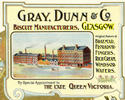 For much of the period most consumer goods were made to order in small workshops. A great deal of clothes making was still done by mothers and daughters. The coming of the Singer Sewing Machine Co, established in Glasgow in 1856, encouraged this and in 1885, when Singer moved the production of machines from their factory in Bridgeton to Clydebank, 5,000 workers were producing 10,000 machines a week. The sewing machine also encouraged the development of sub-contracted tailoring, what was called "sweated labour", with mainly women workers machining at home or in small unregulated workshops to produce cheap ready-made garments. By the last quarter of the century the coming of electrical power was bringing factory-based production, but for this a number of firms moved out of the city to get cheaper labour. In the 1880s there were still more than 300 dressmakers and 300 milliners advertising their services.
For much of the period most consumer goods were made to order in small workshops. A great deal of clothes making was still done by mothers and daughters. The coming of the Singer Sewing Machine Co, established in Glasgow in 1856, encouraged this and in 1885, when Singer moved the production of machines from their factory in Bridgeton to Clydebank, 5,000 workers were producing 10,000 machines a week. The sewing machine also encouraged the development of sub-contracted tailoring, what was called "sweated labour", with mainly women workers machining at home or in small unregulated workshops to produce cheap ready-made garments. By the last quarter of the century the coming of electrical power was bringing factory-based production, but for this a number of firms moved out of the city to get cheaper labour. In the 1880s there were still more than 300 dressmakers and 300 milliners advertising their services.
 The second half of the century saw a rise in living standards for the mass of the population and the beginning of the creation of a mass market. The first demand was for a wider range of foodstuffs and John Bell & Sons were among the first to tap into the huge American meat supplies. Developments in refrigeration in the 1870s allowed frozen lamb, mutton and beef to be imported from the Southern Hemisphere. Improvements in transport allowed dairy produce of all kinds to be moved over distances. Cheap grain from the USA encouraged mass production of bread. J & B. Stevenson in Cranstonhill were by the 1880s suppliers of bread across central Scotland and Bilsland Brothers were producing more than 20,000 dozen white pan loafs by the turn of the century. For the afternoon-tea trade MacFarlane Lang moved from bread-making to fancy-biscuits with the opening of their Victoria biscuit works in 1886 and Bilslands bought an interest in Gray, Dunn & Co of Kinning Park. Smoking was becoming of increasing importance with Glasgow an important centre for the production of clay pipes, by firms such as W White & Son and D MacDougall & Co. As the cigarette gained in popularity, Stephen Mitchell & Co in St Andrew's Square was one of the leading firms in the country, many of which combined into the Imperial Tobacco Co. in 1901.
The second half of the century saw a rise in living standards for the mass of the population and the beginning of the creation of a mass market. The first demand was for a wider range of foodstuffs and John Bell & Sons were among the first to tap into the huge American meat supplies. Developments in refrigeration in the 1870s allowed frozen lamb, mutton and beef to be imported from the Southern Hemisphere. Improvements in transport allowed dairy produce of all kinds to be moved over distances. Cheap grain from the USA encouraged mass production of bread. J & B. Stevenson in Cranstonhill were by the 1880s suppliers of bread across central Scotland and Bilsland Brothers were producing more than 20,000 dozen white pan loafs by the turn of the century. For the afternoon-tea trade MacFarlane Lang moved from bread-making to fancy-biscuits with the opening of their Victoria biscuit works in 1886 and Bilslands bought an interest in Gray, Dunn & Co of Kinning Park. Smoking was becoming of increasing importance with Glasgow an important centre for the production of clay pipes, by firms such as W White & Son and D MacDougall & Co. As the cigarette gained in popularity, Stephen Mitchell & Co in St Andrew's Square was one of the leading firms in the country, many of which combined into the Imperial Tobacco Co. in 1901.
 For inside the house, Glasgow had a large number of paint manufacturers supplying international markets, while James Templeton & Co. pioneered imitations of Persian and Turkish fabrics in the "Axminster" carpets for the middle-class home moving to the "Doges's Palace" premises on Glasgow Green in 1892. Wylie & Lochhead produced furniture for the top of the market, while James Brown in the Gorbals offered "respectable utility". But for all inexpensive consumer goods the Scottish Co-operative Wholesale Society's works in Shieldhall, from the 1880s, was a major supplier.
For inside the house, Glasgow had a large number of paint manufacturers supplying international markets, while James Templeton & Co. pioneered imitations of Persian and Turkish fabrics in the "Axminster" carpets for the middle-class home moving to the "Doges's Palace" premises on Glasgow Green in 1892. Wylie & Lochhead produced furniture for the top of the market, while James Brown in the Gorbals offered "respectable utility". But for all inexpensive consumer goods the Scottish Co-operative Wholesale Society's works in Shieldhall, from the 1880s, was a major supplier.